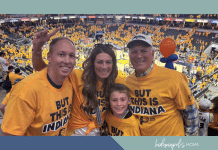 Life on the corner is super-weird, people.
Life on the corner is super-weird, people.
I’m not talking about working the corner—although I’m sure that’s weird too, in different ways. I’m referring to living on a corner.
Corners are very exposed and become involuntary check-points in the landscape of a neighborhood. People recognize our house as “the big green one on the corner.” They use it as a wayfinding tool. At my first neighborhood association meeting, I was asked where I lived in relation to the green house on the corner. “Um. That’s me.”
The school bus stop is on our corner, making it the morning gathering spot for the neighborhood’s children. Each morning, because they are forced to congregate on our corner, I have this irrational sense that they are our responsibility for those 10 minutes. (Or 30 minutes if the IPS buses are running behind.)
Also, apparently Corner = Garbage Can. What is it about being on the corner that causes people to think, “I’ve been collecting these McDonald’s bags in my car for about 6 months, but since I’m driving by this corner, I might as well unload them.” I have been in my yard when a car has driven by, waved, and then casually tossed their garbage out, as if to say, “That’s what you get for being on the corner.”
The street sign on our weird corner has three signs. The street name changes at the intersection, along with the neighborhood. On one side, our neighbor is a mansion with a gated drive and a dog house that I wouldn’t mind living in. (It’s nice. Real nice.) On the other side, our neighbor is a 4-unit rental home, with a collapsing roof and missing an attic window.
It is not lost on me that my family is living on a literal and symbolic boundary. The neighborhoods surrounding downtown Indy are changing. Indy isn’t the first city to experience gentrification and certainly won’t be the last. The existential battle and irony is born from the idea that most of the people participating in the gentrification are those who philosophically are so opposed to it. Like me.
When we moved to Indy and fell in love with our big old green house downtown, we landed precariously on the edge of a changing area. The boarded-up houses are suddenly becoming surrounded by work crews and scaffolding. Abandoned lots now boast For Sale (Build Here!) signs. On our corner, we have a front row seat to the intersection (collision) between the developing neighborhood, and the neighborhood that was.
Here’s the conundrum: I bought my house and I want it to increase in value. I want my neighborhood to be safe. But I also really don’t want to be the impetus for a movement to uproot people from their homes and neighborhoods. I definitely don’t want to be the poster-child for this white-washing of our neighborhood. I can hear it now, “It all started with those white people in the big green house on the corner.” Sigh.
So what do I do? How do I reconcile my anti-gentrification philosophy with the internal me that quietly rejoices when I notice that the homes long forgotten by the non-local investment firms that own them- that have kept them roofless with a torn blue tarp acting as a door- has been purchased and is slated for a remodel that will hopefully attract a local buyer, but through home-flipping-show hallmarks like subway tile and open-concept living?
There is a lot about this societal phenomenon that I can’t control. But there are a few things I can, and encourage my Gladys Kravitz husband to do as well.
- Be a good neighbor. I understand that we are newcomers to a neighborhood that has been home to many of our neighbors for generations. I will be neighborly. I will shovel our sidewalks in a quasi-timely manner. I will give the teenager next door 20 bucks for mowing our lawn to raise money for his basketball fees. I will pick up the garbage without cursing each passing car as a potential deviant litter bug.
- Support neighborhood businesses. Not necessarily the cute, over-priced hipster café where they serve “local” bee pollen and wheat grass. More like, the bar-b-que shack on our corner that has been there for 60 years. I can get behind some pulled pork and baked beans way faster than wheat grass, anyway.
- Develop a deeper understanding of the systemic over-incarceration of Black people. This means acknowledging that having been reared in a white, Eurocentric dominant narrative means that racism is the water in which we swim: my husband and I have to check ourselves and our biases. Part of this means acknowledging that the people who care the most about this neighborhood are the people who have been here much longer than we have: so we will work together to keep it safe. In this, I recognize that my racial and class privilege means that I will be seen and heard differently than some of my neighbors. I will work to have the necessary conversations to take action to change this: everyone deserves to have safe places to live.
- Listen, advocate and celebrate. I will be open to the voices of the neighborhood and their concerns for the changing landscape. I will advocate alongside those who have long fought against housing trends and policies that privilege some, while displacing others. I will learn about and celebrate the neighborhood and its past.
We fell in love with our house because of its history. It is surrounded by houses (and inhabitants) with their own histories and incredible stories to tell. I will do what I can to celebrate our neighborhood’s origin story, even as its story continues to develop.








